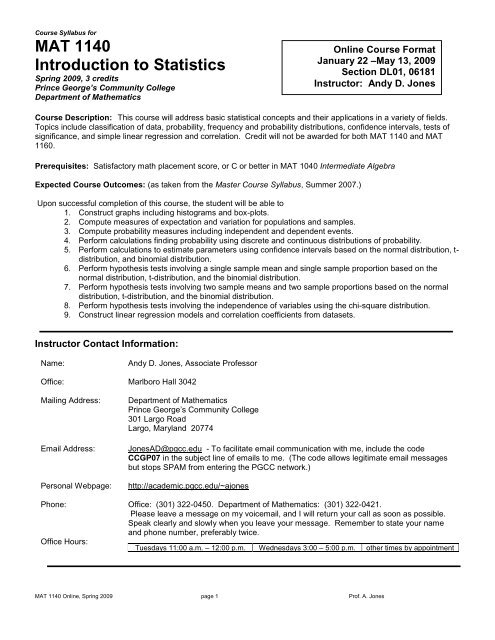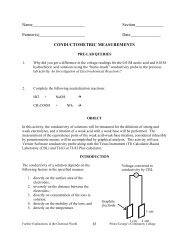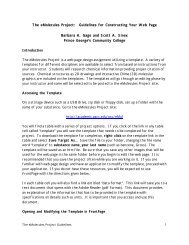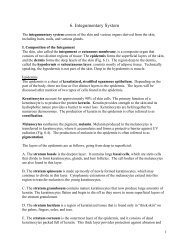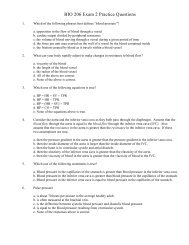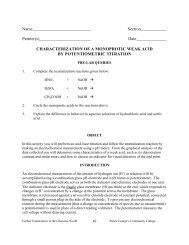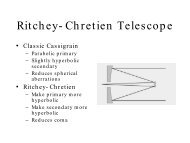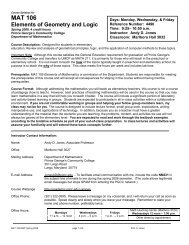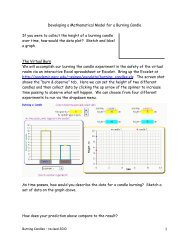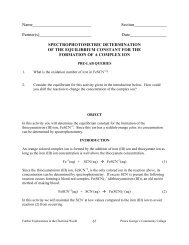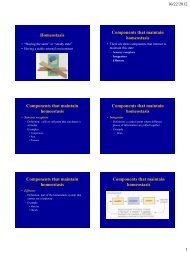Course Syllabus for - Academic Computer Center - Prince George's ...
Course Syllabus for - Academic Computer Center - Prince George's ...
Course Syllabus for - Academic Computer Center - Prince George's ...
You also want an ePaper? Increase the reach of your titles
YUMPU automatically turns print PDFs into web optimized ePapers that Google loves.
<strong>Course</strong> <strong>Syllabus</strong> <strong>for</strong><br />
MAT 1140<br />
Introduction to Statistics<br />
Spring 2009, 3 credits<br />
<strong>Prince</strong> George’s Community College<br />
Department of Mathematics<br />
Online <strong>Course</strong> Format<br />
January 22 –May 13, 2009<br />
Section DL01, 06181<br />
Instructor: Andy D. Jones<br />
<strong>Course</strong> Description: This course will address basic statistical concepts and their applications in a variety of fields.<br />
Topics include classification of data, probability, frequency and probability distributions, confidence intervals, tests of<br />
significance, and simple linear regression and correlation. Credit will not be awarded <strong>for</strong> both MAT 1140 and MAT<br />
1160.<br />
Prerequisites: Satisfactory math placement score, or C or better in MAT 1040 Intermediate Algebra<br />
Expected <strong>Course</strong> Outcomes: (as taken from the Master <strong>Course</strong> <strong>Syllabus</strong>, Summer 2007.)<br />
Upon successful completion of this course, the student will be able to<br />
1. Construct graphs including histograms and box-plots.<br />
2. Compute measures of expectation and variation <strong>for</strong> populations and samples.<br />
3. Compute probability measures including independent and dependent events.<br />
4. Per<strong>for</strong>m calculations finding probability using discrete and continuous distributions of probability.<br />
5. Per<strong>for</strong>m calculations to estimate parameters using confidence intervals based on the normal distribution, t-<br />
distribution, and binomial distribution.<br />
6. Per<strong>for</strong>m hypothesis tests involving a single sample mean and single sample proportion based on the<br />
normal distribution, t-distribution, and the binomial distribution.<br />
7. Per<strong>for</strong>m hypothesis tests involving two sample means and two sample proportions based on the normal<br />
distribution, t-distribution, and the binomial distribution.<br />
8. Per<strong>for</strong>m hypothesis tests involving the independence of variables using the chi-square distribution.<br />
9. Construct linear regression models and correlation coefficients from datasets.<br />
Instructor Contact In<strong>for</strong>mation:<br />
Name:<br />
Andy D. Jones, Associate Professor<br />
Office: Marlboro Hall 3042<br />
Mailing Address:<br />
Email Address:<br />
Personal Webpage:<br />
Department of Mathematics<br />
<strong>Prince</strong> George’s Community College<br />
301 Largo Road<br />
Largo, Maryland 20774<br />
JonesAD@pgcc.edu - To facilitate email communication with me, include the code<br />
CCGP07 in the subject line of emails to me. (The code allows legitimate email messages<br />
but stops SPAM from entering the PGCC network.)<br />
http://academic.pgcc.edu/~ajones<br />
Phone: Office: (301) 322-0450. Department of Mathematics: (301) 322-0421.<br />
Please leave a message on my voicemail, and I will return your call as soon as possible.<br />
Speak clearly and slowly when you leave your message. Remember to state your name<br />
and phone number, preferably twice.<br />
Office Hours:<br />
Tuesdays 11:00 a.m. – 12:00 p.m. Wednesdays 3:00 – 5:00 p.m. other times by appointment<br />
MAT 1140 Online, Spring 2009 page 1 Prof. A. Jones
Required Materials:<br />
Textbook<br />
Aliaga, Martha and Brenda Gunderson. Interactive Statistics, 3 rd edition. Pearson Prentice Hall, 2006.<br />
ISBN: 0-13-149756-1<br />
Calculator<br />
A significant portion of coursework (both assignments and exams) will require the use of a graphing<br />
calculator with statistical functions. Buy or borrow a calculator as soon as possible and learn how to use it.<br />
In-class instruction on the basic use of the calculator will be minimal and will concentrate on the statistical<br />
applications. Sharing calculators during exams is absolutely not permitted. The Texas Instruments TI-83,<br />
TI-83 Plus or TI-84 graphing calculator is highly recommended and will be used in the classroom <strong>for</strong><br />
demonstration purposes.<br />
Blackboard<br />
This online course will use a web-based course delivery program called Blackboard. It serves as the<br />
college's online classroom. You will use Blackboard to communicate with your instructor, to see your<br />
course materials, to submit assignments and to discuss course ideas with your classmates. If you have<br />
never logged into Blackboard, you can find instructions on page 9 of this syllabus.<br />
<strong>Computer</strong><br />
<strong>Computer</strong>/internet access and mastery of basic computer skills are considered to be the student’s<br />
responsibility. The hardware and software requirements <strong>for</strong> taking an online course (as suggested by the Office<br />
of Distance Learning) include<br />
‣ <strong>Computer</strong>: Pentium-class or MAC computer with at least 128 MB RAM<br />
‣ Internet connection: Dial-up 56K modem. Broadband (DSL, Cable-modem, Satellite) is highly<br />
recommended.<br />
‣ Internet Service Provider (ISP): Examples: AOL, Verizon, MSN, NetZero, etc.<br />
‣ Email: Your own personal email address; This is available free through sources such as Yahoo, Hotmail,<br />
and Gmail.<br />
‣ Web Browser: Internet Explorer 6.0 (or higher), Firefox 1.5 (or higher), or Safari 1.2 (or higher)<br />
‣ Software: Word Processing software (Microsoft Word is the college standard); PowerPoint (to view<br />
instructor presentations); Adobe Reader (to view “pdf” files).<br />
‣ It is also suggested that you have access to a printer.<br />
Important Dates:<br />
Spring 2009 Semester<br />
Classes begin Thursday, January 22<br />
Last Day to Drop with Refund Thursday, January 29<br />
No Face-to-Face classes – College closed – Presidents’ Day Monday, February 16<br />
Last day to apply <strong>for</strong> spring graduation Tuesday, February 17<br />
No Face-to-Face classes – College closed – Spring Break Monday-Sunday, April 6-12<br />
Last day to withdraw from full semester classes Friday, April 17<br />
Final Exam period/last week Thursday-Wednesday, May 7-13<br />
Commencement Thursday, May 21<br />
Summer and Fall 2009 Registration<br />
Advance registration <strong>for</strong> summer 2009 Tuesday-Friday, April 14-17<br />
Begin open registration <strong>for</strong> summer 2009 Monday, April 20<br />
Advance registration <strong>for</strong> fall 2009 Monday-Friday, April 27-May 1<br />
Begin open registration <strong>for</strong> fall 2009 Monday, May 4<br />
MAT 1140 Online, Spring 2009 page 2 Prof. A. Jones
<strong>Course</strong> Grading Policy:<br />
Discussion<br />
Board<br />
Postings<br />
5%<br />
Quizzes<br />
15%<br />
During various weeks there will be a discussion question posted on the Discussion Board..<br />
You are to respond to the question in a thoughtful way by beginning a new thread. These<br />
questions may ask you to explore additional online resources or to comment on something<br />
from the textbook. In addition, <strong>for</strong> each posted question, you must respond to at least two<br />
other posts made by your coursemates. A rubric of how your Discussion Board participation<br />
will be assessed can be found in the Communications Policy folder in the <strong>Syllabus</strong> area.<br />
Responses <strong>for</strong> each assigned question are scored out of 10 points. You may expect 8 of<br />
these throughout the course.<br />
Typically at the end of each week, I will assign a quiz to be taken online. For these quizzes,<br />
you may use your textbook and notes. These quizzes will consist of concepts and types of<br />
problems already covered in Powerpoint lectures, readings, and other assignments. These<br />
quizzes will help you prepare <strong>for</strong> the major exams. You may take each quiz only once.<br />
Make sure you complete the quizzes by the deadline as these quizzes cannot be made up.<br />
Once you complete the quiz, you will immediately see you your grade with feedback to help<br />
you understand why your answers were incorrect, if any were. You may expect 15 of them,<br />
each scored as 15 points.<br />
Problem Sets<br />
15%<br />
Almost each week there will be problem set <strong>for</strong> you to submit. These problem sets may<br />
include a few representative problems from the chapter that I ask you to complete. These<br />
problems are very representative of the expectations <strong>for</strong> the exams. These problem sets will<br />
be graded as and returned to you with corrections. You may access your graded problem<br />
sets and my feedback by clicking the grade of the assignment in the gradebook. There will<br />
be approximately 12 of these problem sets worth 15 points each.<br />
There will be four major exams given throughout the course. These exams will be<br />
administered on campus during an open window of time by Student Assessment<br />
Services, Bladen 100. You must come to campus to take your exams. These major exams<br />
will assess your knowledge of a limited number of topics covered in Blocks 1, 2, 3, and 4.<br />
The exams will be scored out of a possible 100 points each. *<br />
Exams<br />
40%<br />
Exam #1: Logic of Statistical Testing and Sampling (Chapters 1 and 2)<br />
Exam #2: Describing Data Graphically and Numerically and Population Models<br />
(Chapters 4, 5, and 6)<br />
Exam #3: Probability and Sampling Distributions (Chapters 7 and 8)<br />
Exam #4: Confidence Intervals and Hypothesis Testing <strong>for</strong> Proportions and Means<br />
(Chapters 9, 10, and 11)<br />
*Your lowest exam score will be replaced by your final exam percentage, if your final exam score is higher. See Late<br />
Assignment, Make Up, and Extra Credit Policy.<br />
Final Exam<br />
25%<br />
The final exam will be comprehensive and measure the expected learning outcomes <strong>for</strong> the<br />
whole course.<br />
<br />
Final Exam: Linear Regression and Chi-Square (Chapters 13 and 14) and<br />
Comprehensive<br />
MAT 1140 Online, Spring 2009 page 3 Prof. A. Jones
Your semester grade is determined using weighted scores in each of these categories, not total points. (Note: We<br />
will learn how to calculate a weighted average during this semester!)<br />
In short, the <strong>for</strong>mula used to compute your weighted average is<br />
Weighted average = (5% x percentage of Discussion Board Points obtained) + (15% x percentage of Quiz points<br />
obtained) + (15% x percentage of Problem Set points obtained) + (40% x percentage of Exam points obtained) +<br />
(25% x percentage of Final Exam points obtained)<br />
A B C D F<br />
90% and above 80% to 89% 70% - 79% 60% - 69% 59% and below<br />
Superior work far<br />
above peers; sets the<br />
standard in<br />
understanding, insight,<br />
or skill.<br />
High quality, solid<br />
work; clearly reflects a<br />
high level of<br />
understanding, insight,<br />
or skill.<br />
Competent, adequate<br />
work and readiness to<br />
continue further<br />
mathematical study.<br />
Low quality work<br />
showing minimal<br />
understanding;<br />
indicates un readiness<br />
to continue in the<br />
sequence.<br />
Representative of work<br />
clearly inadequate and<br />
unworthy of credit.<br />
The instructor reserves the right to make corrections to incorrect grades and discrepancies in grade<br />
calculations displayed in Blackboard's gradebook. <strong>Course</strong> grades will be assigned based on the<br />
procedure above. The instructor's gradebook is the official gradebook.<br />
Policies<br />
Code of Conduct: The <strong>Prince</strong> <strong>George's</strong> Community College Code of Conduct defines the rights and<br />
responsibilities of students and establishes a system of procedures <strong>for</strong> dealing with students charged with violations<br />
of the code and other rules and regulations of the college. A student enrolling in the college assumes an obligation<br />
to conduct himself/herself in a manner compatible with the college's function as an educational institution. Refer to<br />
the 2008-2009 Student Handbook, beginning on page 49, <strong>for</strong> a complete explanation of the Code of Conduct,<br />
including the Code of <strong>Academic</strong> Integrity and the procedure <strong>for</strong> dealing with disruptive student behavior.<br />
<strong>Academic</strong> Integrity: The College is an institution of higher learning that holds academic integrity as its highest<br />
principle. In the pursuit of knowledge, the college community expects that all students, faculty, and staff will share<br />
responsibility <strong>for</strong> adhering to the values of honesty and unquestionable integrity. To support a community<br />
committed to academic achievement and scholarship, the Code of <strong>Academic</strong> Integrity advances the principle of<br />
honest representation in the work that is produced by students seeking to engage fully in the learning process. The<br />
complete text of the Code of <strong>Academic</strong> Integrity is in the 2008-2009 Student Handbook (pages 50-53) and posted<br />
on the college's website. All charges of academic dishonesty will be taken seriously. This includes cheating or<br />
copying on exams and quizzes, submitting another’s out-of-class work as your own, and plagiarizing from sources<br />
such as books, magazines, and the internet. Students who engage in academic dishonesty will receive a failing<br />
grade of zero <strong>for</strong> that particular assignment. Any repeated incident will result in a course grade of “F.” I take<br />
academic dishonesty seriously!<br />
Late Assignments, Make-ups, and Extra Credit:<br />
‣ Due to the nature of an online course, you have a large degree of freedom to decide when you want to<br />
complete problem sets, quizzes, and other assignments. I have also given you a very generous window of<br />
time to complete assignments (always at least one week). There<strong>for</strong>e, I generally will not accept late<br />
assignments. Exceptions to this policy are granted only in extenuating circumstances, and in these cases,<br />
the request <strong>for</strong> an extension must be made in advance of the due date.<br />
‣ There are no make-ups <strong>for</strong> exams. You have one complete business week to take each exam and these<br />
are already scheduled <strong>for</strong> the entire semester (see <strong>Course</strong> Outline). I encourage you to take all exams.<br />
If, <strong>for</strong> some reason, you cannot take an exam, the percentage you earn on the comprehensive final exam<br />
will be substituted <strong>for</strong> the missing exam at the end of the semester. For those students who do take all<br />
exams, the lowest score among the four exams will be replaced by the percentage earned on the<br />
comprehensive final exam (provided that the final exam is higher.)<br />
‣ There is no extra credit available in this course.<br />
MAT 1140 Online, Spring 2009 page 4 Prof. A. Jones
Online <strong>Course</strong> Procedures<br />
Although an online course provides flexibility, it is also important to realize that there are procedures and<br />
deadlines that occur just as in a face-to-face classroom situation. It is a good idea to develop certain<br />
habits and procedures so that you will be able to meet all deadlines and finish the course successfully.<br />
1. Log into Blackboard regularly. I suggest logging in very frequently (at least every other day) to check <strong>for</strong><br />
announcements, emails, postings, due dates, responses to Discussion Board postings, and<br />
assignments. Because everything is posted at least a week in advance, there is no excuse <strong>for</strong> being unaware<br />
of an assignment.<br />
2. At the beginning of each week, check the Assignments tab so you can see what will be due that<br />
week. All assignments and tasks will be due on the Monday (at midnight) following the week <strong>for</strong> which they<br />
were assigned. For example, all tasks assigned during Week 2 will be due on Monday of Week 3. Make sure<br />
you meet the deadlines <strong>for</strong> all assignments. Blackboard will provide me a time and data stamp of when you<br />
actually submitted the items. Late assignments or quizzes will not be accepted. Make sure all assignments are<br />
completed during the week so you will not fall behind. It is hard to catch up!<br />
3. Typically, there will be six types of assignments:<br />
o Read from the textbook: It is imperative that you complete all these assigned readings. Without an<br />
instructor in front of you, the textbook will be your source of in<strong>for</strong>mation. The textbook we are using is<br />
interactive. By that, I mean that you will read a few paragraphs and then be asked to complete a Let's<br />
Do It problem. You should read actively with a pencil, calculator, and paper in front of you, stopping to<br />
do to the indicated problem as indicated. I have provided detailed solutions <strong>for</strong> all Let's Do It problems<br />
in the Content by Chapter tab.<br />
o View provided materials. Powerpoint slides, videos, and applets will be linked to enhance the<br />
textbook discussion. These will generally be found in the Content by Chapter area.<br />
o Work suggested practice problems from the textbook. These problems are <strong>for</strong> you to use as<br />
practice. I will not collect these. I have provided detailed solutions <strong>for</strong> all textbook problems in the<br />
Content by Chapter tab. These practice problems will be excellent examples of test questions.<br />
o Respond to any Discussion Board question that I may have posted. Also make sure you reply to<br />
at least two other student responses. Don't wait until the last minute to do this. It is difficult to have a<br />
discussion if everyone logs in 10 minutes be<strong>for</strong>e the deadline.<br />
o Check <strong>for</strong> the Problem Sets that are due. Typically, every week there will be a problem or<br />
short collection of problems that you will complete and submit <strong>for</strong> points. All problem sets will be<br />
graded <strong>for</strong> correctness. They will be returned to you with feedback. You may access your graded<br />
paper and feedback by clicking the grade of the assignment in your gradebook.<br />
o Finally, take the Chapter Quiz. Typically you will take a short online quiz as we complete each week.<br />
These quizzes are open-book, open-note quizzes. However, you may take them only once. They will<br />
be graded and you will receive immediate feedback on any questions you miss.<br />
4. As you focus on what is due from week to week, keep in mind that exams will be looming in the future.<br />
You can see the testing schedule in the <strong>Course</strong> Outline under the <strong>Syllabus</strong> tab. After each content block is<br />
covered, an exam will be made available in the Student Testing <strong>Center</strong> on the Largo Campus. You will have<br />
one week to take the exam on that content block. Please note, however, that the course will proceed with new<br />
material so it is important that you schedule your study time wisely and in advance.<br />
5. By all means, please feel free to ask questions of me or your classmates when you are stumped or<br />
unclear about something. I truly want this to be a community of learners. You may ask me a question in<br />
Professor J's Virtual Office on the Discussion Board or ask <strong>for</strong> suggestions from your classmates in<br />
Lounge 1140. I prefer that all content questions be directed to the Discussion Board so that everyone in the<br />
course will have the benefit of your question. Of course, any question of a personal nature should be directed<br />
to me in a more private way - either through email, phone call, or office visit.<br />
MAT 1140 Online, Spring 2009 page 5 Prof. A. Jones
Instructor Contact:<br />
The best (and usually fastest) way to reach me is through email or on the Discussion Board. I will usually respond<br />
to email and phone messages within 24 hours except on weekends. I ask that all course content questions be<br />
directed to Professor J’s Virtual Office on the Discussion Board so that all students in the course may benefit from<br />
your question and my answer. Obviously, all questions of a personal nature should be directed to me via email,<br />
phone call, or office visit.<br />
Email: JonesAD@pgcc.edu Phone: (301) 322-0450 Office Location: Marlboro Hall 3042<br />
When emailing me, be sure you provide your full name, the course name, and reference number <strong>for</strong> which you are<br />
enrolled. Be sure to include the code CCGP07 in the subject line so that your email will bypass the college spam<br />
filter. An example email subject line is: James Smith, MAT 1140 - 9783, CCGP07.<br />
Communication Policies and Netiquette:<br />
Most of us have been socialized on how to act, how to react, and what constitutes acceptable behavior in a<br />
classroom. However, because this is the first online class you may have taken, it is important that everyone<br />
understands the social norms of an online classroom. This not only includes what I expect from you in terms of<br />
your participation and online behavior but also what you can expect from me in terms of assessing your<br />
participation and communication skills <strong>for</strong> this course.<br />
Because a great deal of in<strong>for</strong>mation is typically communicated through visual and audio cues such as body<br />
language and emphasis on words, it is important to remember that these cues will not be present in your written<br />
words. There<strong>for</strong>e, it is extremely important that you be aware of the words and language you choose. You should<br />
also remember that expectations are different <strong>for</strong> electronic communication within a course and <strong>for</strong> electronic<br />
communication with your friends and family in emails and chatrooms.<br />
I have <strong>for</strong>mulated some general communication principles as well as some specific guidelines <strong>for</strong> the three<br />
individual types of communication primarily used in this course: discussion board, email, and written assignment<br />
submission. Read them carefully and try your best to honor this policy so that all participants will find the classroom<br />
dialog com<strong>for</strong>table, enjoyable, and meaningful.<br />
General Guidelines <strong>for</strong> all Written Communications:<br />
‣ All responses should be in standard English and free of grammatical errors. Use Spellcheck and correct<br />
capitalization procedures.<br />
‣ All responses should be in paragraph/short answer <strong>for</strong>m and written in complete sentences.<br />
‣ Remember that this is a college-level course and all writing should reflect your own scholarly work. Avoid<br />
plagiarism and be sure to cite any sources that you directly reference.<br />
‣ Do not use abbreviations, smiley faces, or other emoticons that are acceptable in casual chatrooms and<br />
emails but that are unprofessional <strong>for</strong> this type of study.<br />
‣ Please be sensitive to other participants in the course when responding to their comments and emails. If<br />
you do not agree with their conclusions, make your own counterargument in a professional manner without<br />
attacking the other participant personally. Profanity, harassment, and other inappropriate language is<br />
strictly prohibited.<br />
‣ All assignments with due dates are due at midnight (Eastern time zone.) Assignments submitted after<br />
midnight will be considered late.<br />
Posting on the Discussion Board: The online experience does not require synchronous meetings between<br />
students and instructor. That is, we are not required to be in the same place at the same time. Classroom<br />
discussions on various topics will be carried out in a <strong>for</strong>um called the Discussion Board.<br />
‣ Throughout the semester I will post specific discussion questions on the Discussion Board. You are<br />
required to respond thoughtfully to each question I post by beginning a new thread.<br />
‣ Make your responses thoughtful and scholarly after reading any previous posts and doing any indicated<br />
research or reading. Think things through be<strong>for</strong>e responding. Be open to the ideas and questions that<br />
others have.<br />
MAT 1140 Online, Spring 2009 page 6 Prof. A. Jones
Posting on the Discussion Board (cont.):<br />
‣ To encourage dialog within the learning community, you will be required to respond to at least two other<br />
student replies <strong>for</strong> each question. You may wish to add to their response, disagree, or ask follow-up<br />
questions. Participate as much as possible in these group discussions. The whole group will benefit from<br />
open discussion and sharing of thoughts and ideas.<br />
‣ As a general rule, responses to my question should be at four to five sentences long in short answer or<br />
paragraph <strong>for</strong>m.<br />
‣ In replying to other students, refrain from saying what has already been stated. Post comments that only<br />
add to the discussion. "I agree" or "Good point" are encouraging in face to face conversations but when the<br />
participants are trying to keep up with reading all of the postings, this can use up valuable time.<br />
‣ You will be assessed on the content of your response as well as your communication skills such as<br />
grammar and spelling according to the assessment policy of this course. Each original response will be<br />
worth 6 points and each reply will count 2 points. Points will be deducted <strong>for</strong> not following the policies<br />
above (i.e. spelling and grammar) and <strong>for</strong> incomplete or irrelevant responses.<br />
‣ Remember that the words and style of writing that you choose to use reflects on you as an individual and<br />
anything that you post on the Discussion Board will be visible <strong>for</strong> all participants to see.<br />
‣ I generally read all responses and replies to the Discussion Board question within 48 hours and will<br />
sometimes provide feedback. Even if I do not reply to every response, be assured that I am reading your<br />
responses. Sometimes I will refrain from commenting so that the class discussion can flow naturally.<br />
‣ Two standing Discussion Board <strong>for</strong>ums will always be available <strong>for</strong> you to post questions and carry on<br />
conversations. Professor J's Virtual Office is a place you can post questions about statistics that you<br />
would like <strong>for</strong> me to address <strong>for</strong> the entire class. Lounge 1140 is a <strong>for</strong>um <strong>for</strong> student discussions without<br />
intervention from me. I will generally respond to all questions asked in Professor J's Virtual Office within<br />
24 hours, with the exception of weekends.<br />
Sending Emails: Occasionally throughout the course, you may wish to correspond with other students or myself<br />
privately. When doing this, please follow these rules of email netiquette.<br />
‣ You may send an email to anyone (or everyone) in our class from the Communication area.<br />
‣ When emailing me, be sure you provide your full name, the course name, and reference number <strong>for</strong> which<br />
you are enrolled. Be sure to include the code CCGP07 in the subject line so that your email will bypass the<br />
college spam filter. An example email subject line is: James Smith, MAT 114 - 9783, CCGP07.<br />
‣ It is always wise to use a professional email <strong>for</strong>mat and tone to any professor. Personal emails to family<br />
and friends may be in<strong>for</strong>mal and casual. Care should be used when constructing a professional<br />
correspondence.<br />
‣ Avoid flagging messages as being of high importance if they aren't.<br />
‣ Do not send emails outside the scope of this course (such as jokes, inspirational materials, or<br />
advertisements) to me or other course participants.<br />
‣ Do not "reply to all" in your correspondence unless it is assigned. Participants won't want their mailboxes<br />
filled with emails that don't apply to them.<br />
‣ You can generally expect a response to your email in less than 24 hours, with the exception of weekends.<br />
Submitting <strong>Computer</strong> Tasks and Other Written Documents: Throughout the semester you will be assigned<br />
various problems, computer tasks, and other written exercises.<br />
‣ All requested documents should be saved as Word documents so that I may open them at my desktop and<br />
make comments.<br />
‣ Please submit assignments through the View/Complete Assignment function that you will see below the<br />
actual assignment. Save the file on your computer with a meaningful name that identifies the document's<br />
content and your name. Then browse your computer to submit the correct file.<br />
‣ Cut and paste printouts and graphs from Minitab into a Word document. Then save the document <strong>for</strong><br />
submission.<br />
‣ Use appropriate mathematical symbols in all documents in Word:<br />
o You may include many math symbols through the INSERT menu in Word. Go to INSERT →<br />
SYMBOL and then choose the symbol.<br />
o A mathematical <strong>for</strong>mula, expression, or equation may be easily obtained from the INSERT menu<br />
(Insert → Object → Microsoft Equation Editor.)<br />
o You may also find appropriate mathematical symbols in WebEQ on the Text toolbar when you post<br />
in the Discussion Board. You can see the menu of mathematical symbols by clicking "square root<br />
of x."<br />
MAT 1140 Online, Spring 2009 page 7 Prof. A. Jones
College Resources and Support Services:<br />
Mathematics Learning <strong>Center</strong>: Various mathematical resources are available in the Mathematics Learning <strong>Center</strong>,<br />
operated by the Department of Mathematics. These resources include a computer lab, professional teaching<br />
journals, and small rooms <strong>for</strong> group study. Faculty and teaching staff are available <strong>for</strong> homework questions on a<br />
first-come first-served basis. Students needing in-depth tutoring should make an appointment with the Tutoring<br />
<strong>Center</strong> in Bladen Hall (see below).<br />
Marlboro Hall<br />
Room 3104<br />
301-583-5257 Mondays through Thursdays.: 9 am – 8 pm;<br />
Fridays: 9 am – 5 pm;<br />
Sat.: 9 am – 2 pm;<br />
Sun.: Closed<br />
Tutoring <strong>Center</strong>: I encourage you to get free math help from tutors in the Tutoring <strong>Center</strong> and Writing <strong>Center</strong>s.<br />
Students should go to the Tutoring <strong>Center</strong> early and familiarize themselves with the facilities and staff who work<br />
there. Appointments are required. Do not wait until the day be<strong>for</strong>e an exam because slots fill up fast. Visit the<br />
website <strong>for</strong> more in<strong>for</strong>mation: http://www.pgcc.edu/current/academicresources/tutoringwriting.aspx<br />
Bladen Hall<br />
Room 107<br />
301-322-0748 Mon-Thurs.: 8:30 am – 8:30 pm<br />
Fri.: 8:30 am – 4:30 pm<br />
Sat.: 9 am – 3:30 pm<br />
Disability Support Services: Students requesting academic accommodations are required to contact the Disability<br />
Support Services Office (B-124) or call (301) 322-0838 (voice) or (301) 322-0122 (TTY) to establish eligibility <strong>for</strong><br />
services and accommodations. Students with documented disabilities should discuss the matter privately with their<br />
instructors at the beginning of the semester and provide a copy of their Student/Faculty Accommodation Form.<br />
Accommodations cannot be provided until this <strong>for</strong>m is provided.<br />
Open <strong>Computer</strong> Labs: <strong>Computer</strong> access is available in the open computer labs in Bladen Hall Room 104 and High<br />
Technology <strong>Center</strong> Rooms 101 and 201, in addition to the Mathematics Learning <strong>Center</strong> in Marlboro Hall 3104.<br />
Bladen Hall,<br />
Room 104<br />
301-322-0999 Mon.-Thurs.: 8 am – 10 pm<br />
Fri.: 8 am – 5 pm<br />
Sat.: 9 am – 5 pm; Sun.: Closed<br />
High Technology <strong>Center</strong>,<br />
Rooms 101 & 201<br />
301-322-0999 Mon. – Fri.: 8 am – 10 pm<br />
Sat.: Closed; Sun.: Closed<br />
Student Assessment Services <strong>Center</strong> (Testing <strong>Center</strong>): Students will take examinations in the Testing <strong>Center</strong><br />
located in Bladen Hall, Room 100. Consult the web site http://academic.pgcc.edu/sas/index.html or call 301-322-<br />
0090 <strong>for</strong> hours, policies, and procedures. Note that students must always bring a photo ID and a quarter <strong>for</strong> locker<br />
rental when taking an exam. No additional students will be admitted <strong>for</strong> testing 30 minutes prior to the posted<br />
closing time. On the first Friday of every month during the spring semester, the <strong>Center</strong> closes at 2:30 pm with no<br />
admittance after 2:00 p.m.<br />
Bladen Hall,<br />
Room 100<br />
301-322-0090 Mon-Thurs.: 8:30 am – 8:30 pm<br />
Fri.: 8:30 am – 4:30 pm<br />
Sat.: 9 am – 3:30 pm<br />
Library: The Library provides a range of library and media services. Refer to the web site<br />
http://www.pgcc.edu/current/academicresources/library.aspx <strong>for</strong> more in<strong>for</strong>mation about the services. Online library<br />
services, resources and tools are available <strong>for</strong> online students. You may access the online library resources at:<br />
http://www-old.pgcc.edu/library/online.htm.<br />
Lanham Hall<br />
Room 112<br />
301-322-0476 Mon-Thurs.: 8 am – 8 pm; Fri.: 8 am – 5 pm<br />
Sat.: 10 am – 3 pm; Sun.: Closed<br />
MAT 1140 Online, Spring 2009 page 8 Prof. A. Jones
How to Log into Blackboard:<br />
To log in to your Blackboard course, please follow these steps:<br />
1. Go to the <strong>Prince</strong> <strong>George's</strong> Community College Blackboard web site, which is located at<br />
http://pgcconline.blackboard.com. NOTE: There is no "www" in the Blackboard address.<br />
2. ALL STUDENTS must log in to Blackboard using their myPGCC account (this includes students who have<br />
used Blackboard in the past).<br />
3. If you do not have a myPGCC account,<br />
o Go to http://my.pgcc.edu to create a myPGCC account and receive the username and password<br />
you need to log in to Blackboard.<br />
4. If you already have a myPGCC account,<br />
o Go to http://my.pgcc.edu to reset your myPGCC password if you created a myPGCC account<br />
prior to summer 2005. You must change your password to access Blackboard.<br />
5. Once you have your myPGCC account in<strong>for</strong>mation, type it in the Blackboard login box at<br />
http://pgcconline.blackboard.com.<br />
6. If your login is successful, you will see the Blackboard "Welcome" screen. In the box labeled "My <strong>Course</strong>s",<br />
you will see the course or a list of courses in which you are enrolled. Click on the course name to enter<br />
your Blackboard course.<br />
Immediately change your Blackboard email address.<br />
When in<strong>for</strong>mation is downloaded into Blackboard from the college's database, your email address does not<br />
automatically download. The email address first posted in Blackboard is a generic address given to everyone. To<br />
ensure that your instructor can contact you by email, it is VERY important to change your email address as soon as<br />
you log in to Blackboard <strong>for</strong> the first time. Here are the steps <strong>for</strong> changing your Blackboard email address:<br />
1. From YOUR Blackboard Welcome page (you will see WELCOME, ___! in bold letters at the top of this<br />
page), click on Personal In<strong>for</strong>mation in the Tools Box on the left side.<br />
2. Click on Edit Personal In<strong>for</strong>mation.<br />
3. Change your email address to your preferred email address (the one you check most often).<br />
4. Click the Submit button in the lower right corner to save the changes you have made.<br />
Technical Support <strong>for</strong> Your Online <strong>Course</strong>:<br />
Looking <strong>for</strong> answers to technical questions The Technical Support area of the Distance Learning <strong>Center</strong> website<br />
has a wealth of technical in<strong>for</strong>mation including Blackboard login instructions, orientation in<strong>for</strong>mation, hardware and<br />
software requirements, web browser plug-ins and downloads, technical tips and frequently asked questions<br />
(FAQs). The website <strong>for</strong> the DL Technical Support area is: http://www.pgcconline.com/techsupport.html.<br />
If you have visited the DL website and you need additional technical assistance with your online course, you should<br />
contact the Distance Learning <strong>Center</strong> immediately!<br />
Temporary Office (TO) Building<br />
Room 100<br />
Phone: 301-322-0463<br />
FAX: 301-386-7568<br />
Email: DistanceLearn@pgcc.edu<br />
Mon.- Fri.: 8:30 am – 4:30 pm<br />
with phone support available<br />
until 9 pm<br />
MAT 1140 Online, Spring 2009 page 9 Prof. A. Jones
Tentative Schedule <strong>for</strong> MAT 1140 Introduction to Statistics<br />
Online Schedule<br />
subject to change<br />
Week Dates Topic Textbook<br />
1 1/22 - 1/25 Introduction to the <strong>Course</strong><br />
2 1/26 - 2/1 Introduction to Statistical Reasoning Chapter 1<br />
3 2/3 - 2/8 Logic of Hypothesis Testing, p-values, and Statistical Significance Chapter 1<br />
4 2/9 - 2/15 Sampling Methods and Procedures Chapter 2<br />
5 2/16 - 2/22 Exam #1* and Summarizing Data Graphically Chapter 4<br />
6 2/23 - 3/1 Summarizing Data Numerically Chapter 5<br />
7 3/2 - 3/8 Population Models: Normal and Uni<strong>for</strong>m Distributions Chapter 6<br />
8 3/9 - 3/15 Exam #2* and Basics of Probability Chapter 7<br />
9 3/16 - 3/22 Random Variables and Binomial Probability Chapter 7<br />
10 3/23 - 3/29 Sampling Distributions <strong>for</strong> a Proportion & Mean Chapter 8<br />
11 3/30 - 4/5 Exam #3 and Hypothesis Tests and Confidence Intervals <strong>for</strong> Proportions Chapter 9<br />
12 4/6 - 4/12 Spring Break<br />
13 4/13 - 4/19 Hypothesis Tests and Confidence Intervals <strong>for</strong> Means Chapter 10<br />
14 4/20 - 4/26 Comparing Two Treatments Chapter 11<br />
15 4/27 - 5/3 Exam #4* and Examining Relationships between Variables and Regression Chapter 13<br />
16 5/4 - 5/6* Chi-Square Test <strong>for</strong> Independence Chapter 14<br />
5/7 - 5/13** Final Exam* Period<br />
*All exams must be taken in the Student Assessment Services <strong>Center</strong> on the PGCC campus.<br />
MAT 1140 Online, Spring 2009 page 10 Prof. A. Jones


